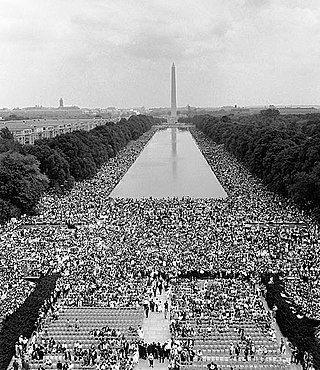
Martin Luther King Jr. was an American Baptist minister, activist, and political philosopher who was one of the most prominent leaders in the civil rights movement from 1955 until his assassination in 1968. A Black church leader and a son of early civil rights activist and minister Martin Luther King Sr., King advanced civil rights for people of color in the United States through nonviolence and civil disobedience. Inspired by his Christian beliefs and the nonviolent activism of Mahatma Gandhi, he led targeted, nonviolent resistance against Jim Crow laws and other forms of discrimination in the United States.

The civil rights movement was a nonviolent social movement and campaign from 1954 to 1968 in the United States to abolish legalized racial segregation, discrimination, and disenfranchisement in the country. The movement had its origins in the Reconstruction era during the late 19th century and had its modern roots in the 1940s, although the movement made its largest legislative gains in the 1960s after years of direct actions and grassroots protests. The social movement's major nonviolent resistance and civil disobedience campaigns eventually secured new protections in federal law for the civil rights of all Americans.

Bayard Rustin was an African-American leader in social movements for civil rights, socialism, nonviolence, and gay rights.

The Congress of Racial Equality (CORE) is an African-American civil rights organization in the United States that played a pivotal role for African Americans in the civil rights movement. Founded in 1942, its stated mission is "to bring about equality for all people regardless of race, creed, sex, age, disability, sexual orientation, religion or ethnic background."

Asa Philip Randolph was an American labor unionist and civil rights activist. In 1925, he organized and led the Brotherhood of Sleeping Car Porters, the first successful African-American-led labor union. In the early Civil Rights Movement and the Labor Movement, Randolph was a prominent voice. His continuous agitation with the support of fellow labor rights activists against racist labor practices helped lead President Franklin D. Roosevelt to issue Executive Order 8802 in 1941, banning discrimination in the defense industries during World War II. The group then successfully maintained pressure, so that President Harry S. Truman proposed a new Civil Rights Act and issued Executive Orders 9980 and 9981 in 1948, promoting fair employment and anti-discrimination policies in federal government hiring, and ending racial segregation in the armed services.

The March on Washington for Jobs and Freedom, also known as simply the March on Washington or The Great March on Washington, was held in Washington, D.C., on August 28, 1963. The purpose of the march was to advocate for the civil and economic rights of African Americans. At the march, final speaker Dr. Martin Luther King Jr., standing in front of the Lincoln Memorial, delivered his historic "I Have a Dream" speech in which he called for an end to racism and Racial Segregation.

James Morris Lawson Jr. is an American activist and university professor. He was a leading theoretician and tactician of nonviolence within the Civil Rights Movement. During the 1960s, he served as a mentor to the Nashville Student Movement and the Student Nonviolent Coordinating Committee. He was expelled from Vanderbilt University for his civil rights activism in 1960, and later served as a pastor in Los Angeles for 25 years.

The Southern Christian Leadership Conference (SCLC) is an African-American civil rights organization based in Atlanta, Georgia. SCLC is closely associated with its first president, Martin Luther King Jr., who had a large role in the American civil rights movement.

The Martin Luther King Jr. National Historical Park covers about 35 acres (0.14 km2) and includes several sites in Atlanta, Georgia related to the life and work of civil rights leader Martin Luther King Jr. Within the park is his boyhood home, and Ebenezer Baptist Church — the church where King was baptized and both he and his father, Martin Luther King Sr., were pastors — as well as, the grave site of King, Jr., and his wife, civil rights activist Coretta Scott King.

The Big Six—Martin Luther King Jr., James Farmer, John Lewis, A. Philip Randolph, Roy Wilkins and Whitney Young—were the leaders of six prominent civil rights organizations who were instrumental in the organization of the March on Washington for Jobs and Freedom in 1963, at the height of the Civil Rights Movement in the United States.

Clayborne Carson is an American academic who is a professor of history at Stanford University and director of the Martin Luther King, Jr., Research and Education Institute. Since 1985, he has directed the Martin Luther King Papers Project, a long-term project to edit and publish the papers of Martin Luther King Jr.

Cordy Tindell Vivian was an American minister, author, and close friend and lieutenant of Martin Luther King Jr. during the civil rights movement. Vivian resided in Atlanta, Georgia, and founded the C. T. Vivian Leadership Institute, Inc. He was a member of the Alpha Phi Alpha fraternity.
The Prayer Pilgrimage for Freedom, or Prayer Pilgrimage to Washington, was a 1957 demonstration in Washington, D.C., an early event in the Civil Rights Movement of the 1950s and 1960s. It was the occasion for Martin Luther King Jr.'s Give Us the Ballot speech.
Glenn Smiley was a white civil rights consultant and leader. He closely studied the doctrine of Mahatma Gandhi and became convinced that racism and segregation were most likely to be overcome without the use of violence, and began studying and teaching peaceful tactics. As an employee of the Fellowship of Reconciliation (FOR), he visited Martin Luther King Jr. in Montgomery, Alabama in 1956 during the Montgomery bus boycott where Smiley advised King and his associates on nonviolent tactics, and was able to convince King that nonviolence was a feasible solution to racial tension. Smiley, together with Bayard Rustin and others, helped convince King and his associates that complete nonviolence and nonviolent direct action were the most effective methods and tools to use during protest. After the Civil Rights Movement, Smiley continued to employ nonviolence and worked for several organizations promoting peace in South American countries. Just three years before his 1993 death, Smiley opened the King Center in Los Angeles.
Council for United Civil Rights Leadership (CUCRL) was an umbrella group formed in June 1963 to organize and regulate the Civil Rights Movement. The Council brought leaders of Black civil rights organizations together with white donors in business and philanthropy. It successfully arranged the August 1963 March on Washington for Jobs and Freedom with the Kennedy administration.
The history of the 1954 to 1968 American civil rights movement has been depicted and documented in film, song, theater, television, and the visual arts. These presentations add to and maintain cultural awareness and understanding of the goals, tactics, and accomplishments of the people who organized and participated in this nonviolent movement.
This is a timeline of the civil rights movement in the United States, a nonviolent mid-20th century freedom movement to gain legal equality and the enforcement of constitutional rights for people of color. The goals of the movement included securing equal protection under the law, ending legally institutionalized racial discrimination, and gaining equal access to public facilities, education reform, fair housing, and the ability to vote.
The Youth March for Integrated Schools in 1958 was the first of two Youth Marches that rallied in Washington, D.C. The second took place the following year. On October 25, 1958, approximately 10,000 young people, mostly of high school to college age, marched to the Lincoln Memorial to promote the desegregation of American public schools. The event was organised by a committee led by A. Philip Randolph, a prominent civil rights activist, who published a statement detailing the purposes and motives for the demonstration. Randolph described the primary purpose as giving 'dramatization to the God-given right of every child, regardless of race or color, religion or national origin or ancestry, to receive an education in the public schools, free from the insult of segregation and discrimination.' He further requested that a delegation led by Harry Belafonte, consisting of five white members and six black members of the Youth March, meet with President Eisenhower to promote the desegregation of schools; however, this delegation was blocked.

The 1964 Nobel Peace Prize was awarded to the American Baptist minister and activist Martin Luther King Jr. (1929–1968) "for his non-violent struggle for civil rights for the Afro-American population." He is the twelfth American recipient to the prestigious Peace Prize.












